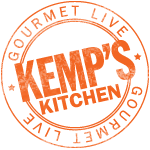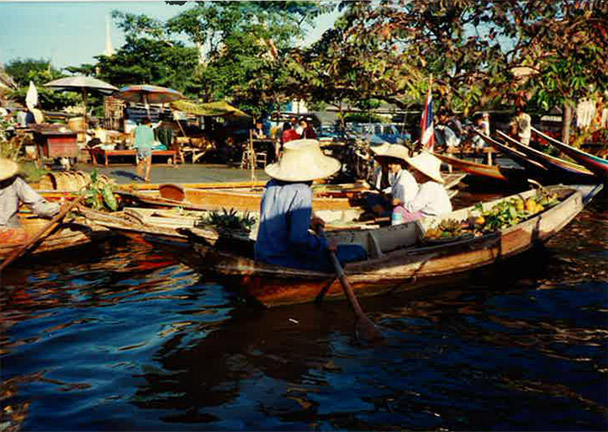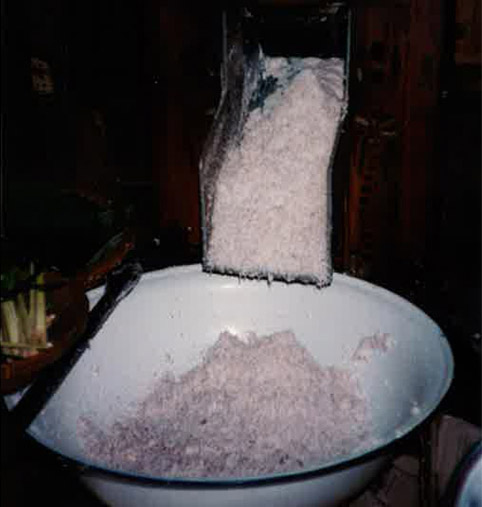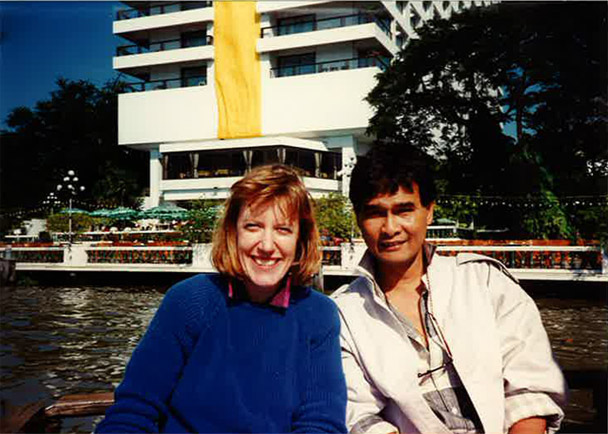
And thus began one of the great adventures of my life.
Montant's plan revolved around my spending a week at the cooking school recently opened by the Oriental Hotel (now the Mandarin Oriental) in Bangkok, which was where she'd tasted those life–changing soups. The editor–in–chief knew a trend when she tasted one, and, of course, these days tom yaam goong, the clear brothy shrimp soup, and tom kha kai, the creamy chicken and coconut milk soup, are (along with pad thai), probably the best–known—and most popular—items on any Thai menu in the United States.
So, a month later I found myself on a plane crossing the Pacific on my way to Bangkok. Imagine an all–expenses–paid week at one of the finest hotels in the world to study Thai cooking! Unreal, right? To this day, I still can't believe how lucky I was.
A Westerner's first visit to the Far East is always a total sensory shock: the crowds, the smells, the diesel fog, the cacophony of local music mixed with the annoying antique Western pop tunes you thought you'd erased from your brain, the street signs and billboards you can't read, and the wild–looking produce you've never seen before. As the taxi pulled up to the Oriental Hotel, I'll admit I felt a bit awkward—I'd never stayed in such an elegant hotel before. How much do I tip? Do I have to dress up for breakfast? Can I wear flip–flops in the lobby? But I was also grateful, after the zigzag ride there, just to have a serene retreat from honking car horns, buzzing motorcycles, and air pollution that, I soon discovered, left you with a sore throat after several hours out and about on the streets. Not that my room was exactly a citadel far removed from city life. Proof that I was in the middle of Bangkok lay just outside my window, where a fellow sold sun–dried squid hung with clothespins on a line stretched between two poles.
My good fortune continued when I learned that there was only one other student for a week of classes with space for 20—practically a private tutorial. This couldn't have been more ideal for absorbing a completely new cuisine with exotic ingredients: lemongrass, kaffir limes and their leaves, galanga, and homemade coconut milk, along with the more pungent items such as fish sauce and shrimp paste. This list sounds like old hat to today's foodies, who have long since adopted many of these ingredients in their day–to–day cooking—even growing a few in their gardens—but in 1987, it was all so new to me that I was giddy with excitement.

Our teacher was Chalie Amatyakul, a cosmopolitan Thai from an aristocratic family, who'd learned to cook while hanging around the staff in his home kitchen, learning from his mother what it took to supervise a household and how each dish ought to taste. Although he held a degree in political science from Bangkok's top university, he'd gone into the hotel business and traveled extensively, all the while sharpening his fluency in French, English, and German. Queen Sirikit favored Amatyakul as her caterer for many state functions and had brought him along to organize the parties during her 1985 tour of the United States.
For the cooking–school curriculum, Chalie had researched old cookbooks to find classic dishes that would give students tastes of authentic Thai cooking while using only the ingredients he knew we could find at home (foods he'd been able to track down in the few urban pockets of Thai immigration in the U.S.). Chalie was all about cooking from scratch, so coconut milk was squeezed from grated coconut blended with water in two different extractions, one thicker than the other, and curry pastes were pounded into submission by hand using pestles in heavy stone mortars. "You must break open the pores to bring out the flavor," he insisted. "A food processor does not do the same thing." Classes began promptly every morning at 9 a.m. with a lecture, followed by a demonstration of several dishes, and a little hands–on action by us. My classmate, Honey Strait (a horticulturist from Connecticut), and I made lunch out of the morning's demos, so we could get out and about in the afternoon. We hired a boatman to take us to the floating markets and hopped into tuk–tuks (motorized rickshaws) to tool all over the city, stopping at every market, as well as every important temple and Buddha.
A childhood friend who'd lived in Thailand for several years put me in touch with Bob Halliday, then the food critic for the Bangkok Post. Bob made sure to get me off the tourist track so I could experience what he considered real down–home Thai food. It was an experience, all right. I remember chattering away at a large round table with a group of Bob's Thai and expat friends when I suddenly heard an odd sound that reminded me of a pissed–off Donald Duck. It came from the direction of a nearby couple—but they were not the ones squabbling. It was the two large rats underneath their table having the argument, locked together in a teeth–baring, knockdown fight over some tasty morsels on the floor. Halliday smiled sheepishly, and while he was busy reassuring me that the food was worth waiting for, I ever so casually lifted my feet off the floor and tucked them under my butt.

It was with Bob that I tasted my first durian. These days, I see durians everywhere in Chinatown, but in the late 1980s the durian had reached mythic status—the stinky fruit that was too smelly to be brought aboard airplanes. Trying durian for the first time is a bit like your hope for your first encounter with sex: You want to be with someone who knows what they're doing. So I lined up Halliday, purchased a durian around the corner from his apartment, and he pried open the thorny outer covering.
What was it like? After all the buildup to "the durian experience" I can't say it was a letdown, because I almost liked the creamy yellow flesh that lay inside the prickly rind. I certainly didn't find it anywhere near as disgusting as I'd been warned it would be. In texture and flavor it reminded me of a ripe Camembert cheese, and as long as I didn't think of it as a sweet fruit, I could begin to understand why it was so prized in Asia.
My week at cooking school in Thailand did two things: It whetted my appetite for more—I was quite smitten—and it humbled me into realizing how much I didn't know. That didn't stop me from turning the little piece Montant had suggested I write into a 3,000–word article, not including the accompanying ten recipes, which took almost four more full pages of text.
When it came time to run through the recipes in our Gourmet test kitchen, I had a hard time tracking down the ingredients, even in Chinatown. I had to comb the streets, looking for the telltale Thai script or Vietnamese writing on store awnings, and pester shopkeepers with questions. Thai food was still new and exotic in New York City, so the kaffir lime leaves, fresh holy basil, or lemongrass were often hidden in the back or frozen, and you had to ask for them. Repeatedly.
Today, you need go no farther than your neighborhood supermarket for ready–made curry pastes, canned coconut milk, bottles of fish sauce, and bags of rice noodles. Even if you want to be a DIYer and make your own curry pastes, you can find everything you need fresh in Southeast Asian markets, many generic Asian stores that had previously been strictly Chinese, and most surprising of all, even in upscale supermarkets with exotic produce sections.
There is one lesson from my trip that, 25 years later, remains at the center of my culinary existence: the importance of balancing flavors within every dish. There's nothing revolutionary about this—it's the core principle in all cuisines—but in Thai cooking it's heightened. The major players are so very unsubtle—the salty funk of fish sauce and shrimp paste, the sourness of tamarind or lime juice, the citrusy perfume of kaffir lime leaves, the sweetness of palm sugar and coconut milk, the jazzy kick of fresh herbs, and the heat of chiles and peppercorns—so the art of bringing them together to create something complex and delicious takes skill and practice.
It's working at balancing everything I cook that makes my time in the kitchen so much fun. I'm constantly tasting, thinking, and adjusting. When I throw together a salad dressing, for example, I offset the shrill of the lemon or lime juice with a little anchovy paste and sea salt, add sweetness with some minced shallots or a smidgen of maple syrup, and some body and heat with a little mustard, all before whisking in some olive oil. Then I taste it again and keep adjusting until I love it. That's what I call satisfaction.
Kemp Minifie was wrapped up in all aspects of food at Gourmet magazine for 32 years, and is now part of the Epicurious team.

